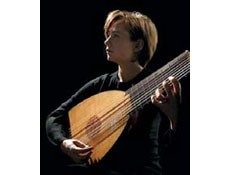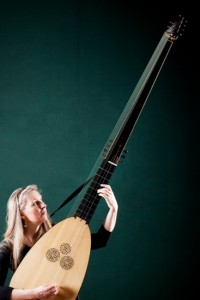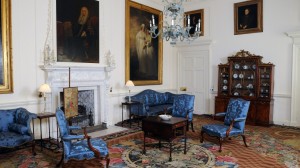Extending theorbo players from the inside
 Head of Early Music Liz Kenny has been getting out of her comfort zone, playing very new music for a very old instrument: I use my instrument the theorbo – the largest of the lute family with an extra long neck – for many things: annoying people on crowded tube trains, confusing airlines, accompanying students, demonstrating continuo harmonies, playing with singers and baroque ensembles . . . and so on. I rarely play anything contemporary on it, but every now and then the opportunity arises to enlarge the solo repertoire with something new. A year or so ago I was inserted into the Hebrides Ensemble – a top team of players based in Scotland, who eat new music for breakfast and are rightly celebrated for their spirit of adventure and musical excellence – to work on the premiere of James Macmillan’s Since it Was the Day of Preparation, an Easter-inspired work for five singers and five players. It took us all a few days to get used to each other – for them, balancing with a relatively feeble old instrument; for me, remembering how to count bars’ rest after years of playing continuo or solo where you start at bar one and stop at the end. We played the premiere at the Edinburgh Festival in 2013. It was a great experience, so when James Macmillan invited me to play for his new Cumnock Tryst Festival in Ayrshire, and encouraged me to programme old alongside new music, it seemed like a great idea.
Head of Early Music Liz Kenny has been getting out of her comfort zone, playing very new music for a very old instrument: I use my instrument the theorbo – the largest of the lute family with an extra long neck – for many things: annoying people on crowded tube trains, confusing airlines, accompanying students, demonstrating continuo harmonies, playing with singers and baroque ensembles . . . and so on. I rarely play anything contemporary on it, but every now and then the opportunity arises to enlarge the solo repertoire with something new. A year or so ago I was inserted into the Hebrides Ensemble – a top team of players based in Scotland, who eat new music for breakfast and are rightly celebrated for their spirit of adventure and musical excellence – to work on the premiere of James Macmillan’s Since it Was the Day of Preparation, an Easter-inspired work for five singers and five players. It took us all a few days to get used to each other – for them, balancing with a relatively feeble old instrument; for me, remembering how to count bars’ rest after years of playing continuo or solo where you start at bar one and stop at the end. We played the premiere at the Edinburgh Festival in 2013. It was a great experience, so when James Macmillan invited me to play for his new Cumnock Tryst Festival in Ayrshire, and encouraged me to programme old alongside new music, it seemed like a great idea.

I’d heard and liked some of Ben Oliver’s music in one of the Turner Sims lunchtime concerts, and he’d rashly said if ever I was interested in anything new…so a crash course in his other work (there’s lots of it on his website, check it out) convinced me to ask him for a piece. And a really easy one, please, for a newbie of the new . . . First off we had to settle the notation: lute players play from tablature of varying degrees of obscurity, but this seemed like a torture too far and potentially restrictive, so we went for staff notation with a lot of bass clef to suit the instrument’s range. Then, deciding on a tuning: like the banjo, there are many and various ways to tune different theorboes and lutes, but we went for a tuning that is reasonably common. My colleague Lynda Sayce has a great website which helped through the maze.
The theorbo has a re-entrant tuning (I know your eyes are glazing over, but just give it another sentence) which means the highest pitch string is the third one down; then there are the long basses which can be re-tuned to change key. Slightly regretted letting Ben in on that one, as he chose to retune almost all of them, but spookily the two he left unchanged were the two that Macmillan had changed, so I ended up giving the world premiere of re-tuning – all seven bass-strings during the concert. Practised that at home. A lot.
And then a piece emerged: to me as if my magic, to Ben out of the giant chart he’d made of all the notes on all the frets. A preliminary look confirmed pretty much nothing to change, then over to me to work out where and on what strings to play it, as there are a lot of possible choices depending on what sound, colour, shape of fingers etc you have and want. Being booted out of my comfort zone of clichés I’ve amassed from playing a lot of 17th century solos was exhilarating and alarming in equal measure. A trip to Ben’s house the week before to find out which bits would go wrong revealed the answer: almost all of it, so it was back to the drawing-fretboard for a bit. Recommend this before recitals: pick someone who makes you nervous, like the composer – no matter how genial and patient they are – then sit approx. 3 feet away from them and play it. Then wait for them to tell you…oh yes, this is what having a lesson is like. So I learned some great new music and maybe how to be a better teacher.

For the inaugural Cumnock Tryst Festival last month, I gave two performances of Ben’s new piece and Macmillian’s solo theorbo motet from Since It Was The Day of Preparation as part of a triptych of Promenade-style concerts at the beautiful Dumfries House. The Glasgow Herald liked it:
… a solo theorbo recital is rare thing, but the Tapestry Room of Dumfries House with a log fire spitting behind the audience was the perfect context for Elizabeth Kenny to play a little motet by MacMillan and a wonderful new piece by Benjamin Oliver, Extending from the Inside, which sounded a little like King Crimson’s Robert Fripp guesting with the Young Marble Giants.
I love Robert Fripp. Young Marble giants are new to me, hooray for YouTube. I hope to play Extending from the Inside on a Monday lunchtime in the Spring. See you there!
